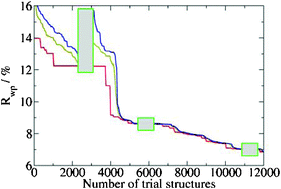Counteracting stagnation in genetic algorithm calculations by implementation of a micro genetic algorithm strategy
Abstract
A new strategy for implementing the concept of a “micro genetic algorithm” within a standard genetic algorithm (GA) procedure is proposed. The strategy operates by applying criteria to test for the occurrence of stagnation within the population of a standard GA calculation, and triggering the micro-GA procedure whenever stagnation is detected. The micro-GA is implemented in terms of the parallel evolution of a number of small sub-populations (comprising predominantly new randomly generated structures together with a few of the best structures from the stagnated population), and the sub-population of highest quality following the micro-GA procedure is used in the construction of the next population of the standard GA calculation. The micro-GA procedure is applied in the context of a GA for carrying out direct-space structure solution from


 Please wait while we load your content...
Please wait while we load your content...